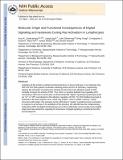| dc.contributor.author | Das, Jayajit | |
| dc.contributor.author | Zikherman, Julie | |
| dc.contributor.author | Yang, Ming | |
| dc.contributor.author | Govern, Christopher C. | |
| dc.contributor.author | Ho, Mary | |
| dc.contributor.author | Weiss, Arthur | |
| dc.contributor.author | Roose, Jeroen | |
| dc.contributor.author | Chakraborty, Arup K | |
| dc.date.accessioned | 2013-08-08T17:04:07Z | |
| dc.date.available | 2013-08-08T17:04:07Z | |
| dc.date.issued | 2009-04 | |
| dc.identifier.issn | 1937-9145 | |
| dc.identifier.issn | 1945-0877 | |
| dc.identifier.uri | http://hdl.handle.net/1721.1/79806 | |
| dc.description | available in PMC 2009 October 1; A presentation from the EMBO workshop "Visualizing Immune System Complexity," Centre d'Immunologie Marseille-Luminy, Marseille, France, 15 to 17 January 2009. | en_US |
| dc.description.abstract | Activation of Ras proteins underlies functional decisions in diverse cell types. Two molecules, Ras-GRP and SOS (Ras–guanine nucleotide–releasing protein and Son of Sevenless, respectively), catalyze Ras activation in lymphocytes. Binding of active Ras to the allosteric pocket of SOS markedly increases the activity of SOS. Thus, there is a positive feedback loop regulating SOS. Combining in silico and in vitro studies, we demonstrate that "digital" signaling in lymphocytes (cells are "on" or "off") is predicated on this allosteric regulation of SOS. The SOS feedback loop leads to hysteresis in the dose-response curve, which may enable T cells to exhibit "memory" of past encounters with antigen. Ras activation by Ras-GRP alone is "analog" (a graded increase in activation in response to an increase in the amplitude of the stimulus). We describe how the complementary analog (Ras-GRP) and digital (SOS) pathways act on Ras to efficiently convert analog input to digital output and make predictions regarding the importance of digital signaling in lymphocyte function and development. | en_US |
| dc.description.sponsorship | Rosalind Russell Arthritis Center | en_US |
| dc.description.sponsorship | Howard Hughes Medical Institute | en_US |
| dc.description.sponsorship | National Institutes of Health (U.S.) | en_US |
| dc.description.sponsorship | Arthritis Foundation | en_US |
| dc.language.iso | en_US | |
| dc.publisher | American Association for the Advancement of Science | en_US |
| dc.relation.isversionof | http://dx.doi.org/10.1126/scisignal.266pt2 | en_US |
| dc.rights | Article is made available in accordance with the publisher's policy and may be subject to US copyright law. Please refer to the publisher's site for terms of use. | en_US |
| dc.source | PubMed Central | en_US |
| dc.title | Molecular Origin and Functional Consequences of Digital Signaling and Hysteresis During Ras Activation in Lymphocytes | en_US |
| dc.type | Article | en_US |
| dc.identifier.citation | Chakraborty, A. K., J. Das, J. Zikherman, M. Yang, C. C. Govern, M. Ho, A. Weiss, and J. Roose. “Molecular Origin and Functional Consequences of Digital Signaling and Hysteresis During Ras Activation in Lymphocytes.” Science Signaling 2, no. 66 (April 14, 2009): pt2-pt2. | en_US |
| dc.contributor.department | Massachusetts Institute of Technology. Institute for Medical Engineering & Science | en_US |
| dc.contributor.department | Massachusetts Institute of Technology. Department of Biological Engineering | en_US |
| dc.contributor.department | Massachusetts Institute of Technology. Department of Chemical Engineering | en_US |
| dc.contributor.department | Massachusetts Institute of Technology. Department of Chemistry | en_US |
| dc.contributor.mitauthor | Chakraborty, Arup K. | en_US |
| dc.contributor.mitauthor | Das, Jayajit | en_US |
| dc.contributor.mitauthor | Yang, Ming | en_US |
| dc.contributor.mitauthor | Govern, Christopher C. | en_US |
| dc.relation.journal | Science Signaling | en_US |
| dc.eprint.version | Author's final manuscript | en_US |
| dc.type.uri | http://purl.org/eprint/type/JournalArticle | en_US |
| eprint.status | http://purl.org/eprint/status/PeerReviewed | en_US |
| dspace.orderedauthors | Chakraborty, A. K.; Das, J.; Zikherman, J.; Yang, M.; Govern, C. C.; Ho, M.; Weiss, A.; Roose, J. | en_US |
| dc.identifier.orcid | https://orcid.org/0000-0003-1268-9602 | |
| mit.license | PUBLISHER_POLICY | en_US |
| mit.metadata.status | Complete | |

